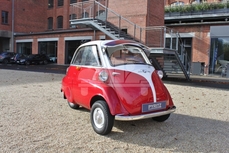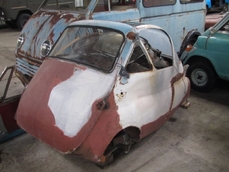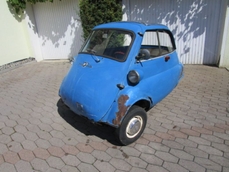BMW Isetta Coupe 1957
Allgemeine Beschreibung :
The world might have missed out on such legendary BMWs as the 3.0 CSL, M1, and M3 had it not been for an Italian appliance company named Isothermos. The loose connection between the mighty Bavarian automaker and Isothermos began in 1942 when by a young engineer and heir to an industrial fortune, Renzo Rivolta purchased Isothermos. Rivolta was passionate about all things petrol-powered, and he began to expand the company’s range, adding motorbikes to the portfolio, renaming the works Iso Autoveicoli S.p.A. After World War II, Europeans were desperate to get back on wheels, but with raw materials and fuel at a premium, few could afford a conventional car. Motorbikes and scooters became hugely popular, but they were impractical in bad weather or for anyone with a family. As a way to bridge the gap between bike and car, some manufacturers turned to motorbike-powered microcars that offered cheap, efficient, and practical transport for the masses.
Wanting to cash in on this new market, Renzo Rivolta began development of a 2-passenger microcar with a single front clamshell door, and a small capacity motorbike engine mounted amidships. Introduced in 1953, the Iso Isetta Turismo was the quintessential bubble car. It was adorable, it could transport two people and a few belongings, and it was highly efficient although not particularly quick thanks to having just 236cc and 9 ½ horsepower. It turned out to be reasonably successful in the home market, with 20,000 built at the Iso works in Milan.
Rivolta recognized a viable market for the Isetta; however, he lacked the manufacturing capacity to meet Europe-wide demand. Rivolta’s stroke of genius came in 1954 when he sold the rights to the design to several different companies in Europe and South America. Among those firms was BMW, who was struggling through the post-war recovery. Most of their factories were devastated by bombing, and their Eisenach works fell within Russian-controlled East Germany. BMW’s post-war product line consisted mainly of expensive six and eight-cylinder luxury cars that, while capable, had limited appeal in the post-war economy. Without the time and resources to develop a small car, the Isetta was the perfect opportunity to support the bottom line. Of course, they couldn’t help but to fettle with the design, modifying it to accept a 250 c.c. four-stroke engine shared with the R25/3 motorcycle and making minor styling changes. In 1956, BMW bumped the capacity to 298cc which gave the new Isetta 300 nearly one-and-a-half times the power output over the 250. With a storming 13 horsepower on tap, not even hills could stop BMW’s mighty-mouse! The Isetta continues to delight today’s collectors, and some of the most serious collections make room for the little German bubble car of outsized importance.
Offered here is an excellent example of BMW’s iconic Isetta microcar. This 1957 model wears a well-maintained older restoration, presented in two-tone Pastellblau and Bayerische Blau. The two-tone color scheme is a factory-offered livery, pleasingly finished and detailed with an array of period-correct details and accessories. Paintwork is in good order, with glossy and consistent surfaces, and a small touchup found here and there, upon close inspection. The fit of the clamshell front door is very good, and the body rubbers and minor trim are in excellent condition. Chrome is also excellent, with straight bumper bars and overrider tubes front and rear. The car rides on correct cream-colored steel wheels, shod with black wall tires and brushed alloy hubcaps.
With room for two passengers and a few groceries on the parcel shelf, the Isetta interior is cozy yet also refreshingly straightforward, with only the bare essentials needed for getting to and fro. Vinyl-covered panels line the body sides and inside of the door, and this example features a matching gray vinyl upholstered bench seat. Every Isetta features a sunroof, which also doubles as an exit should the front door become blocked. The sunroof vinyl cover and frame mechanism are in excellent working order. Controls and switchgear appear original and in similarly good condition throughout the interior.
The single-cylinder BMW motorbike engine runs very well, thanks to a recent service and carburetor tune. Access is easy thanks to a removable side panel, and the engine is clean and well-presented with proper finishes and fittings. The suspension and driveline are in similarly good order, and the car exhibits excellent road manners. With just 13 horsepower on tap, every drive in an Isetta is an adventure, and it is nearly impossible not to smile when stirring the 4-speed gearbox and listening to the little single-cylinder buzz of this well-sorted example. Despite its humble roots and diminutive size, the Isetta casts an outsized shadow over the history of the German motoring industry, saving BMW from certain takeover, and providing the storied firm its opportunity to continue on to greatness.
https://hymanltd.com/vehicles/6484
1957 BMW Isetta Coupe is listed verkauft on ClassicDigest in St. Louis by Mark Hyman for $32500.
Fakten der Auto
Karosserietyp : Auto Marke : BMW Modell : Isetta Ausführung : Coupe Hubraum : 0.0 Modelljahr : 1957 Karosstyp : Coupé Lage : Missouri
Verkauft
Angaben Zum Verkäufer
Verkauft
People who viewed this BMW Isetta also viewed similar BMW listed at ClassicDigest
Other cars listed for sale by this dealer
über BMW
Bayerische Motoren Werke, allgemein bekannt als BMW, hat eine reiche Geschichte, die bis zu ihrer Gründung im Jahr 1916 zurückreicht. Ursprünglich als Flugzeugmotorenhersteller während des Ersten Weltkriegs gegründet, sah sich BMW nach dem Krieg Beschränkungen bei der Flugzeugproduktion gegenüber. Als Reaktion darauf verlagerte das Unternehmen 1923 seinen Fokus auf die Motorradproduktion, was den Beginn seiner Beteiligung an der Automobilindustrie markierte. Anschließend stieg BMW 1928 in die Welt der Automobile ein, indem es den DIXI produzierte, im Wesentlichen eine lizenzierte Version des Austin 7 von der Austin Motor Company.In den 1930er Jahren begann BMW, sich als Hersteller von eleganten und leistungsstarken Fahrzeugen zu etablieren. Ein bemerkenswertes Modell aus dieser Zeit ist der BMW 327, der 1937 eingeführt wurde. Der 327 war sowohl als Coupé als auch als Cabriolet erhältlich und zeigte das Engagement der Marke für Luxus und Stil. Darüber hinaus erzielte BMW in dieser Zeit im Sportwagenrennsport Erfolge, insbesondere mit dem BMW 328. Der 328, der 1936 debütierte, wurde für seine Leistung und Aerodynamik bekannt. BMW setzte den 328 in verschiedenen Rennveranstaltungen ein, darunter die prestigeträchtige Mille Miglia, bei der das Unternehmen mehrere aerodynamische Spezialmodelle präsentierte.
Die Nachkriegszeit erwies sich für BMW als herausfordernd, und das Unternehmen sah sich finanziellen Schwierigkeiten gegenüber, die beinahe zu einem Konkurs führten. Dennoch gelang es BMW, sich zu erholen und wieder aufzubauen und schließlich zu einer der führenden Premium-Automarken weltweit zu werden.
Als die 1960er Jahre begannen, festigte BMW weiter seinen Ruf als Hersteller von sportlichen und luxuriösen Fahrzeugen. Im Jahr 1968 wurde der BMW 2002 eingeführt und markierte die Geburt der "Neuen Klasse" kompakter, sportlicher Limousinen. Der 2002 erlangte Popularität durch sein agiles Handling und seine Leistung und legte den Grundstein für das sportliche Image von BMW.
Mit den 1970er Jahren erweiterte BMW seine Modellpalette mit der Einführung der E9-Plattform, zu der der ikonische BMW 3.0 CS Coupé gehörte. Die E9-Serie zeigte das Engagement von BMW für die Verbindung von Leistung und Luxus. Im Jahr 1972 feierte der M1, das erste mittelmotorgetriebene Sportwagen von BMW, sein Debüt. Der M1 wurde zunächst als Rennwagen entwickelt, wurde aber später auch als Straßenfahrzeug angeboten. Der M1 legte den Grundstein für die leistungsstarke M-Serie von BMW.
Ende der 1970er Jahre wurde die BMW E24 6er-Reihe eingeführt, die eine Kombination aus Luxus und Leistung bot. Die 6er-Reihe umfasste Modelle wie den 630CS, 633CSi und 635CSi und wurde zum Symbol für Eleganz und Fahrvergnügen.
Durch diese Meilensteine und das Engagement für Innovation und Leistung hat sich BMW zu einem Schwergewicht in der Automobilindustrie entwickelt und behauptet weiterhin seinen Status als eine der führenden Premiummarken weltweit.











